ARIZONA
January 14–February 8, 2009
Rationale
Last winter was cold, windy, snowy, and icy.
Cabin fever set in early and lasted until April. We decided not this
year! A road trip to a warm part of the country was in order. Arizona
beckoned for a number of reasons: warm weather, friends
and family, and interesting places to visit.
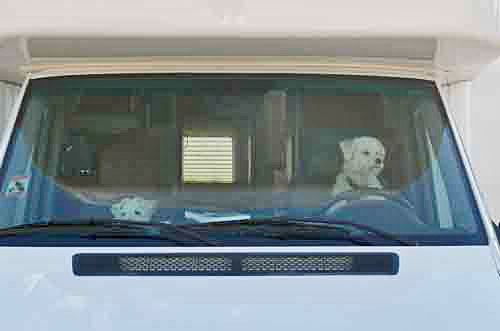
To get ready for the trip, to be
sure we
could get
on the road, we parked the RV at the top of our dirt drive so we
could avoid an icy hill on our road and make it to the plowed pavement
without worry. It was a smart move
because in spite of a snow-covered driveway, we got out
easily. From there, our itinerary took us down I-25 to Santa Fe and
Albuquerque,
then west to Flagstaff, Ashfork, and south to Wickenburg; west to
Quartzite; east and south to Karchner Caverns near Tombstone; north to
Tucson, Cave
Creek, and Sedona—and several places in between. Part of the trip was
planned beforehand, and part was decided on the fly. Both made sense,
and both proved the right thing to do.
Was the month away from home a success? You bet it
was. We found warm weather, good people to visit, and interesting
places. And some unanticipated pleasures.
Visiting Friends and Family
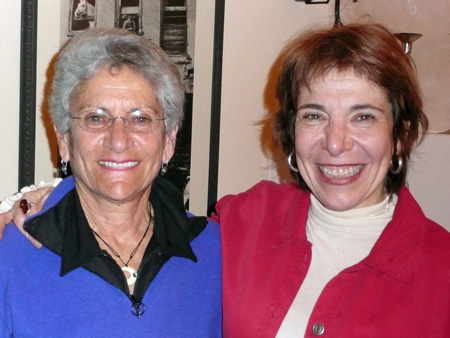
The rules say, “Fish and
family…” and we
followed the rules carefully. As a result we enjoyed being with folks
we hadn’t seen in a long time and didn’t outstay our welcome. At least
we don’t think we did.
1.
Santa Fe
Judy had recently learned that a daughter of
a first cousin (does that make her a second cousin? first cousin once
removed?)
lives and works out of Santa Fe. Judy and Gail had not seen each other
since childhood, but the “reunion” was as though the half century
between visits was like last week. Yes, there was
lots
of catching up to do, pictures to share, and
family
stories to tell, but it all seemed to
come easily for the two of them. All the time, her
shepherd puppy, Max, made life interesting for Sophie and Bella.
We were only able to spend an evening together, but a connection was
made. We’ll see her
again this summer at a Chasan family reunion back east, so we saved
some
talk for then.
2.
Albuquerque
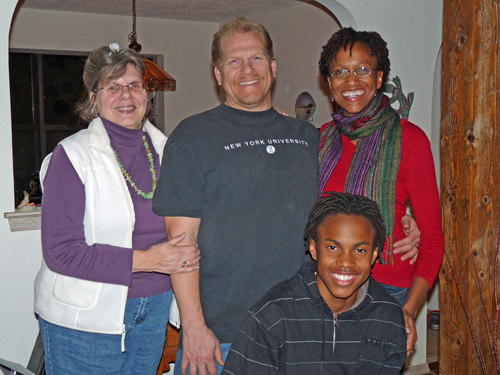
We have stayed in touch with Anna
Marie since
we knew her in Ohio nearly 40 years ago. We have visited so often and
shared so many
experiences with her family—four-wheel trips in Silverton, impromptu
bridge games, glug parties, naughty dogs, and more—that getting
together is as easy as dropping in on a next door neighbor.
She also knows all the good places in Albuquerque
and what’s happening; she always offers dozens of choices of places to
visit, interesting restaurants, and special events. Since she lives
about an hour south of Santa Fe, we arrived well before lunch in time
to shop the
Benalillo Thrift Store (rating: B+), have a good Mexican lunch (and a
great margarita)
at Bernalillo
’s Range
Café, visited the
historic Silva’s
Saloon next door. It claims to hold the first liquor license in the
state and the oldest “continuous
saloon in the country!” On the way home we walked
through the stunning Sandia Indian Casino.
We covered a lot of ground in a short time.
That evening, Eric (her son) and his wife Pam and
her son Jabare came over for drinks and finger foods. At 7:00, a friend
came over to make a fourth for bridge. We played until 11:00 and went
to bed exhausted. We left late the next morning for Flagstaff.
3.
Tucson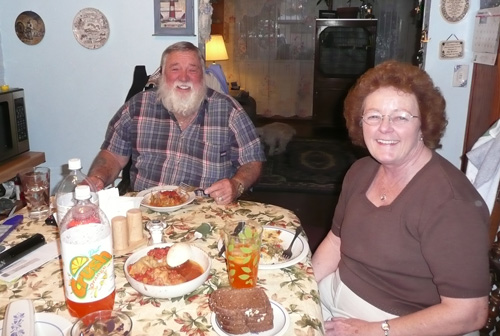
After several weeks of camping around
the
state, we made our way to Tucson to visit Judy’s cousin, Bob, and his
wife Ginny whom we saw two winters ago in Arizona. As we did with Anna
Marie, we packed a lot into just a few days with them.
Bob is very much a family historian, as well as a
storyteller and yard sale maven (and, as you can see in the photo, he
has a number of Santa gigs around Christmas). We laughed at his family
stories, along the way learning who in the family was who. After all,
Judy’s dad was one of eight children who immigrated to this country and
most had several children who had several children who had several
children… you get the idea. Keeping everyone straight requires either
some genealogical digging or a prodigious memory. Bob has the memory.
The first evening we had terrific dinner at one of
Tucson’s finest/best known/most popular Mexican restaurants, La Parrilla Suiza.
In the morning, Hughes went to yard sales with Bob, watching and
listening and learning from the “master,” who’s widely known around
town as Trader Bob. He buys low, fixes/refurbishes/polishes other
people’s castoffs, and resells it all (or most of it) at swap meets.
This day he spent about $50 for what he thinks will bring in 4-5 times
that; e.g., a pickup truck toolbox that he purchased for $20 sold two
weeks later for $90. Plus we met a lot of nice folks along the way.
In the afternoon, Bob’s son, Bobby, treated Bob and
me to a performance at the Tucson Music Hall of “A Bronx Tale,” a one-man
show starring the author, Chazz Palminteri. What a stunning
performance: 90 minutes of one guy creating nearly a dozen characters
and telling a compelling coming of age story with humor, strong
characters, and inspiration. Don
’t
miss it if it comes to your town. Thank you, Bobby, for getting
us there.
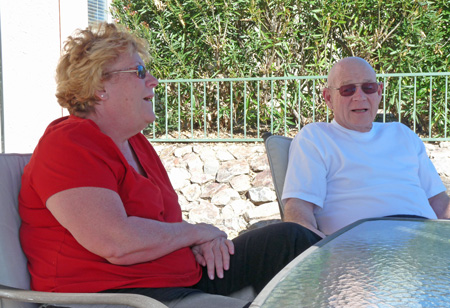
Judy, meanwhile, spent much of the
afternoon with
Ginny at a birthday party of one of Ginny’s friends, a party complete
with a harpist and a flower cake.
That evening, Ginny served up stuffed
cabbage that
would make Toledo’s Tony Packo proud.
Afterward, until we couldn’t keep our eyes open any longer, Bob
dug out a researched genealogy chart and we shared more family stories.
4.
Marana
About 20 miles north of downtown Tucson is
the growing suburb of Marana where Nederland neighbors Jim and Sandi
spend most of the winter. (Need we mention they are very smart people?)
Their spacious condo is near several golf courses and backs up to a
wash where animals of all kinds gather. From their patio, we saw more
wildlife than at any other one spot on the trip.
We arrived on Super Bowl Sunday, awash in the
statewide excitement of the Arizona Cardinals playing. While no one
gave them much of a chance against Pittsburgh, the game turned out to
be one of the best Super Bowls ever: closely played, a lead that went
back and forth, some outstanding plays, and at least some controversy.
(Did you love watching the close-up of Steelers linebacker-thug
James Harrison punching an Arizona player who was lying on the ground?
Shouldn’t that result in an
ejection and a fine? I guess Mr. Harrison has immunity.)
Anyway, dirty play
aside, we all agreed it
was an exciting game—and Jim’s new HDTV was marvelously bright and
incredibly sharp.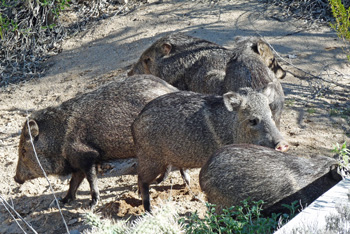
Judy did her morning run on the neighborhood trails;
Jim and Hughes walked at the same time, photographing the several
varieties of cacti growing there, plus a herd of javalinas—nine in
all—in
the upper part of the wash that runs behind their condo.
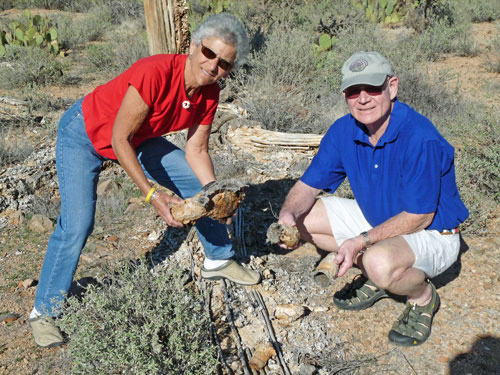 In the
afternoon, Jim took us to Saguaro
National Park
(the west section);
Sandi preferred to take care of the dogs, whom she seems to adore. We
stopped by Jeb’s Rock Shop on the way to look over his collection of
local and imported specimens and be audience to his stories
about rock collecting and gemstones. We stopped at the National Park
Visitors Center to
find out where we might take a gentle hike. The Bajada Loop Road took
us to Signal Hill picnic area (built by the CCC in 1934), which is a
short walk to
the
location of petroglyphs on a rock outcropping. We found several saguaro
boots (see photo on left) and one rare cristate
(or crowned) saguaro, which occurs in about one in 200,000 saguaros.
In the
afternoon, Jim took us to Saguaro
National Park
(the west section);
Sandi preferred to take care of the dogs, whom she seems to adore. We
stopped by Jeb’s Rock Shop on the way to look over his collection of
local and imported specimens and be audience to his stories
about rock collecting and gemstones. We stopped at the National Park
Visitors Center to
find out where we might take a gentle hike. The Bajada Loop Road took
us to Signal Hill picnic area (built by the CCC in 1934), which is a
short walk to
the
location of petroglyphs on a rock outcropping. We found several saguaro
boots (see photo on left) and one rare cristate
(or crowned) saguaro, which occurs in about one in 200,000 saguaros.
[Note: You
’ve got to really, really love saguaros to visit this
park—there are lots and lots of saguaros everywhere and not
much else. Only real saguaro lovers go in the summer.]
Camping
in Arizona
In between visits with family and friends,
we camped
our way across the state, setting up in both RV parks and in the
boondocks dry camping. Sometimes we drove out on BLM land for a single
night, and sometimes we parked our RV in a town or campground for
several
days. The dogs preferred the freedom of BLM dry camping where they were
permitted open spaces to explore without a leash. And while we liked
staying in one place for several nights and enjoying the opportunities
of each town or campground, we preferred the serenity and
solitude of the well-off-the-road camping that public lands provide.
1. Wickenburg
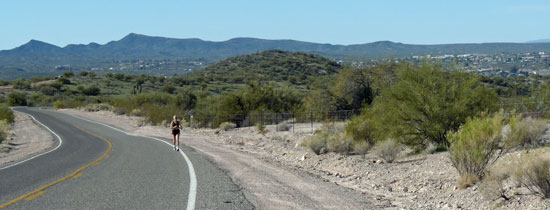
The
area
between
Phoenix and the California border always looks like a blank area on
maps: nothing but sand and sagebrush, poisonous snakes, bleached bones,
and the rusting carcasses of old cars that didn’t make the full trip. We had heard
of
Wickenburg, but what we
thought was a sleepy desert town in that space between Phoenix and the
Colorado River turned out to be an oasis of warm weather, a great
biking and running area, a good place for birding and rockhounding,
home to a fine museum, close to the richest gold mine in Arizona
history, and home to just over 5,000 really nice folks. Our three days
there were full, yet we left lots of to do on our next visit.
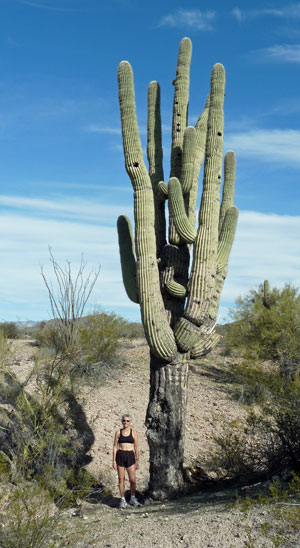 We stayed three
nights at the
Desert Cypress RV Park, a
comfortable and quiet place close to town and to dirt roads for
biking and running. Paul and Barb Root were the very pleasant and
helpful managers on site while we were there; in fact, Paul spent a
good hour fixing the cable TV connection that had
been
undone by the folks who installed the TV converter box back in the fall
and didn't properly test the system before I picked it up. (Having a
working TV permitted us to watch the Arizona Cardinals win a spot in
the Super Bowl and the inauguration of Barack Obama. We may have been
the only ones in the park or town watching the inauguration, though
everyone watched the Cardinals beat the Eagles.) We had planned for
only one night, but stayed two more.
We stayed three
nights at the
Desert Cypress RV Park, a
comfortable and quiet place close to town and to dirt roads for
biking and running. Paul and Barb Root were the very pleasant and
helpful managers on site while we were there; in fact, Paul spent a
good hour fixing the cable TV connection that had
been
undone by the folks who installed the TV converter box back in the fall
and didn't properly test the system before I picked it up. (Having a
working TV permitted us to watch the Arizona Cardinals win a spot in
the Super Bowl and the inauguration of Barack Obama. We may have been
the only ones in the park or town watching the inauguration, though
everyone watched the Cardinals beat the Eagles.) We had planned for
only one night, but stayed two more.
Wickenburg’s claim to be a true western town is hard
to dispute. The town’s history
and development are grounded in mining and ranching. It has a fine museum of local history
(especially good exhibits on gold mining, rodeos, wild wests, ranching,
western art, and dude ranches), the Webb Center for the Performing
Arts, some high-end developments with golf courses, and an airport. The Hassayampa River (an Apache word
meaning “the river that runs upside down”) flows through town and is home to a Nature
Conservancy Preserve perfect
for bird watching. There are also at least three pretty good thrift
stores in town, the best one run by the Soroptimists (rating: A+). The town also hosts an annual Cowboy
Poetry
Gathering in early December. The folks living there seem to
enjoy
their active, yet laid back life in the high desert.
Judy ran and Hughes biked every morning along
Constellation
Road, which heads north and east of town into cactus country where
rockhounds and ATVs love to explore. Together we biked through town,
visiting art galleries, the museum, the jail tree (for the nearly 30
years when the town had no jail, prisoners were shackled to a mesquite
tree), and thrift shops. We paid a visit to the excellent Bar
S Animal Clinic on our way out of town where Dr. Colleen McCullum,
a vet just down from Homer, Alaska, saw Sophie for an incontinence
problem and gave her some magic pills that provided immediate relief
and, so
far, a cure.
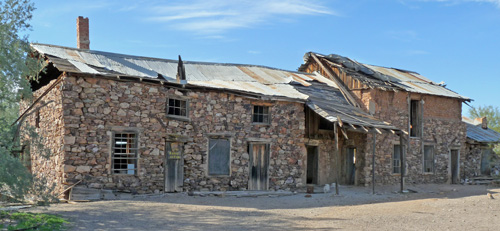
Just 15 miles outside of Wickenburg is the Vulture
Mine, which was discovered by Henry
Wickenburg in 1863 (or 1864), and the (now ghost) town of Vulture
City that boomed to a population of 5,000. After five years, Henry
sold 80% of the mine and took up ranching. Sadly, he died a pauper by
his own hand in 1905. In 1942, when the government banned gold mining,
the mine closed and 5,000 people left the town to the desert. The
property was
eventually bought and opened to visitors for $10/person.
[Note: The
property is
currently for sale
to anyone
interested in purchasing a town.]
We took the dogs on a walking tour through
the remarkably well preserved buildings and equipment. Some
buildings, like that Assay Office pictured here, were built from ore
taken from the mine. A
few hundred yards from the mine and mill area is the schoolhouse which,
except for the outhouse that tilts precariously, remains in pretty good
condition. Outside, the swing, slide, and teeter-totters still work. We
have seen a lot of derelict mines, mills, and ghost towns, but the
Vulture is one
of the best for really understanding how people lived and worked
extracting precious minerals from the ground. It was well worth the fee
and the two hours to explore.
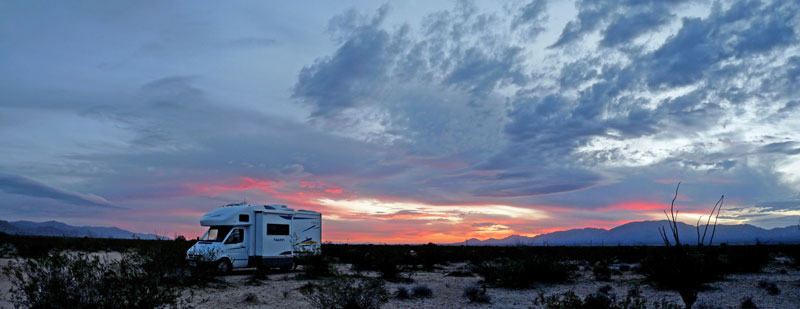 After leaving Vulture City, we continued west on US 60 to
Wenden and turned north toward Alamo Lake to dry camp on BLM land
somewhere on Bonanza
Mine Road near the slopes of the Harcuvar Mountains. Before sunset, we
pulled off on a level spot where we could
hear nothing, where the stars were not dimmed by city lights, and
where the sunset and the sunrise (pictured here) were spectacular. We
had a warm dinner, a long walk with the dogs, and
slept warm and peacefully. Some would say we finally did some camping
(even though we slept in our RV).
After leaving Vulture City, we continued west on US 60 to
Wenden and turned north toward Alamo Lake to dry camp on BLM land
somewhere on Bonanza
Mine Road near the slopes of the Harcuvar Mountains. Before sunset, we
pulled off on a level spot where we could
hear nothing, where the stars were not dimmed by city lights, and
where the sunset and the sunrise (pictured here) were spectacular. We
had a warm dinner, a long walk with the dogs, and
slept warm and peacefully. Some would say we finally did some camping
(even though we slept in our RV).
2. Swansea
Though we were headed for Quartzite, we had read
about
the Bouse Mine and the townsite of Swansea,
both north of US 60, but not too far out of our way. The Bouse Mine
proved small and not particularly good for rockhounding.
We did not spend long there, though we did pass through town when the
“bread
man”
was there: we’re not sure if this is a daily, weekly,
or a once-in-a-while event, but the bread man came loaded with day-old
bread,
bagels, donuts, and rolls from Safeway (we don’t know which one) and folks in Bouse
helped themselves to whatever they liked and as much as they wanted. No one seemed greedy, and there
was plenty for all. So, for a few minutes, we were honorary citizens of
Bouse and walked away with bagels and bread to last a week.
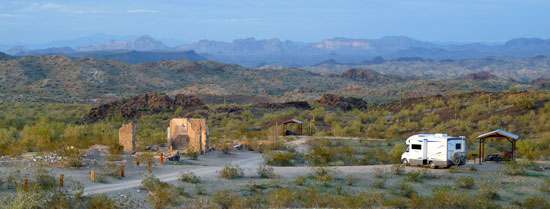
While Bouse is
on paved State Highway 72, the road to Swansea
is 30 miles of regularly graded dirt. We didn’t travel much over 30 MPH, but
even so
the dishes rattled and the dogs were on alert. The last three miles
were in rough condition, though we never doubted we could drive
that section. (It would be impassible in wet weather!) We were rewarded
with the remains of a prosperous copper mining town settled in 1908
which grew when a railroad spur was built linking Swansea to Bouse. The
population fluctuated as the price of copper went up and down. The town
was abandoned in the 1930s.
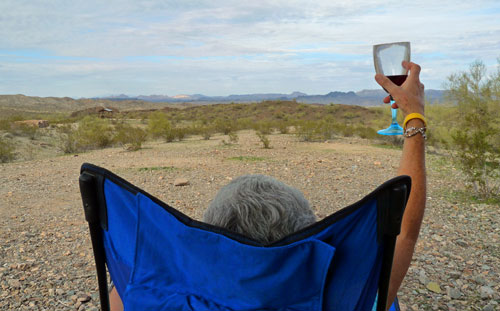 We tried to
imagine
500 people or
more living out here toiling
in the mines for copper. Fifty tons a day were taken either to the
Colorado River and on to Wales, or to the railroad headed for
Wickenburg
or Parker.) Discovered in 1882, developed in 1886, the mines were
profitable from 1908 until they petered out in the Depression and the
town went ghost in the 1940s. This isolated, desolate area supported a
school, newspaper, electric company, post office, movie house,
hospital, and housing for hundreds of men, women, and children.
The beauty of the town in the winter months, when the temperature is in
the low 70s, hides the harsh reality of summer heat well over 115°.
Swansea (originally named Signal) is a world away from the Welsh town
that was its namesake. All that remains of the community that once gave
hope of prosperity are the adobe rubble of living quarters, the smelter
and dust chamber, the foundations of stores and company offices, and
the glory hole that yielded the ore.
We tried to
imagine
500 people or
more living out here toiling
in the mines for copper. Fifty tons a day were taken either to the
Colorado River and on to Wales, or to the railroad headed for
Wickenburg
or Parker.) Discovered in 1882, developed in 1886, the mines were
profitable from 1908 until they petered out in the Depression and the
town went ghost in the 1940s. This isolated, desolate area supported a
school, newspaper, electric company, post office, movie house,
hospital, and housing for hundreds of men, women, and children.
The beauty of the town in the winter months, when the temperature is in
the low 70s, hides the harsh reality of summer heat well over 115°.
Swansea (originally named Signal) is a world away from the Welsh town
that was its namesake. All that remains of the community that once gave
hope of prosperity are the adobe rubble of living quarters, the smelter
and dust chamber, the foundations of stores and company offices, and
the glory hole that yielded the ore.
Weather, vandals, and neglect have reduced much of
what was a jewel in the middle of nowhere to only a hint of its former
grandeur. Still, for rockhounds, mining history buffs, and 4-wheelers,
Swansea is worth the drive. Camping here for the night, we found the
quietest place on earth where
you can see more stars than we thought existed, a place where dogs can
roam freely and a person could sit quietly with a glass of wine and see
mountains hundreds of miles off on the horizon.
3.
Quartzite

If you've been to Quartzite
in the summer, you probably get to know most everyone in town pretty
fast because
there are not very many folks who live with +110°. On the
other hand, if you've been there in the winter months, you've been
among over 1,000,000 visitors—some say as many as 4,000,000—
who come for
what might be the world’s largest swap meet, plus gem and mineral
shows, Indian pow wows, RV and vacation expos, and other events to
which snowbirds flock. We decided to find out what the other 999,998
people see in this circus extravaganza. We saw and now we know. And we
might even go back again!!
Not knowing how things were spread out on one of the
busiest weekends of the Quartzite winter season, we phoned for
reservations in August. Given all the No
Vacancy signs at the dozens of RV parks, we're glad we did. Our
stay at 88
Shades RV Park was very pleasant. Our site was small but
sufficient. The facilities were spotless and we even got free laundry
in new machines. Oranges and grapefruits grown on the property are
picked regularly and guests at the park can take what they’d like. The park sponsors host of
activities
from scheduled social gatherings to free concerts; they offer a lending
library, a game
room, and a small auditorium where once a week local musicians (many
who live at the park) present a country
and western music jam which is, we were told, always well attended. We
enjoyed it and the house was packed. The park is located in the heart of town,
which we
wanted since we had only our bikes to get around. We feel fortunate
to have made a good choice for this weekend.
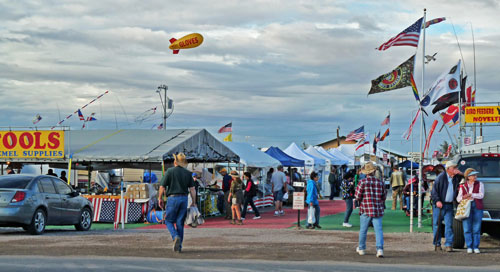
There were four or five main “shows” going on simultaneously: the Desert
Gardens International Gem and Jewelry Show; The “World Famous Main
Event,” (read flea market); the QIA Pow Wow Rock & Mineral Show;
the Quartzite Sports, Vacation & RV Show; the Tyson Wells Rock
& Gem show, plus ongoing swap meets at “Prospectors Panorama” and
the “Rice Ranch.” In addition, there are organized areas of smaller
flea markets all over the town, and RV dealers are showing and selling
RVs everywhere. It’s a phenomenon that has sprung up only in the last
31 years. We shopped each day until we almost literally dropped. Though
we bought little, we saw lots: some of the minerals were remarkable and
most of the swap meet items were ordinary but inexpensive. Most
interesting to us was the Vacation and RV Show with merchandise and
vacation information from which we learned a lot. At the end of each
day, we were pooped and glad to get back to the relative quiet of
our campground.
4. Tonopah
Leaving Quartzite was a breeze. We unhooked, washed
out the sewer line, filled the gallon jugs we keep inside, and then
drove over to the park’s Car/RV wash facility and power hosed
off the dust and grime we’d picked up on the dirt roads. We filled with
diesel ($2.19/gallon) and headed east on I-10. We aimed for Tonopah,
just
an hour or so east on the interstate, where we turned off at this
crossroads of a town, stopped for ten minutes at a roadside informal
flea market (just couldn’t pass it up), then headed for the base
of
Saddle Mountain about eight miles southwest of Tonopah where James
Mitchell’s Gem Trails of Arizona
(Gem Guides: 2001) guided us to the location
of an “eminent southwest mineral collecting spot” noted for “beautiful
fire agate and chalcedony…In addition rock hounds can occasionally find
crystal-filled geodes on the lower slopes, but they are not too common.”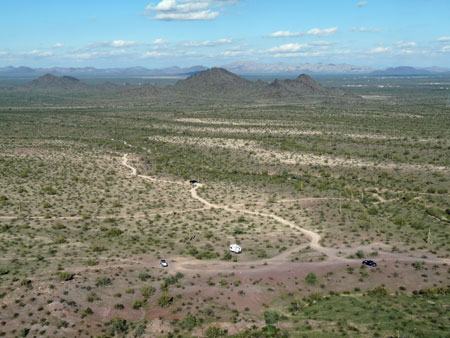
Though we found small agates and not much fire and
no geodes at all, we did enjoy hiking the sides of Saddle Mountain
(3,037') and
found an outstanding place to dry camp for the night. We added the few
mineral specimens we found to those from Swansea, Bouse, and
Wickenburg. Once
again we found quiet and solitude well off the road. What a pleasure
after the hustle and bustle of Quartzite!
In the morning, Judy went for a run along the
shoulder of the back road leading into Tonopah. It was the first time
she ran since she fell off her bike in Quartzite and banged up her knee
pretty well; no blood, but plenty of bruising and enough pain to cause
concern. She did her four miles in
normal time but ran tentatively and with some discomfort.
[Note:
The Friday
after we got home, Judy went in for an exam with an orthopod here
in Boulder who did an x-ray and then ordered an MRI. She went over the
MRI results with Judy the following Wednesday and advised her to lay
off running for a month, which was not what she wanted to hear, but a
better prescription than surgery.]
5. Picacho
State Park
We had hoped to poke through another “eminent mineral collecting spot,” the Ramsey Mine near Painted Rocks
Petroglyph Site west of Gila Bend. When we finally found the road,
which
could have been easily missed in the past, there was an large
hand-painted sign blocking the road
indicating the mine was closed by the owner “due to the bastards who stole diesel
fuel, shovels…also winch (and) barbeque.” We were disappointed, but
certainly
understood his hostility.
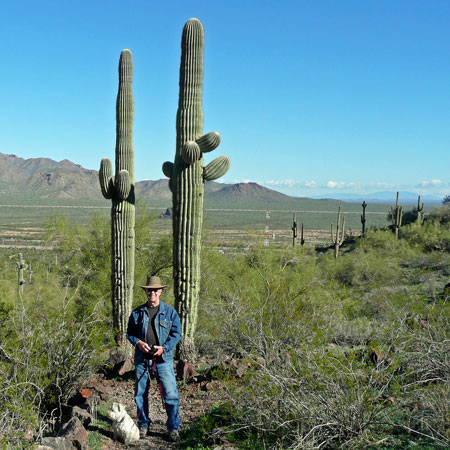
Just a
short way back, we stopped for a picnic lunch
at the Painted
Rocks Petroglyph Site. This area protects a small
outcropping of rock with Hohokam petroglyphs. It is remarkable that
these, like so many others that date back nearly 2,000 years, have not
been
vandalized or destroyed or stolen by ignorant visitors. With
no hiking of interest and rather bleak scenery, we let the dogs free
for a while and then
headed east until it was time to stop for the
night. Quite by chance and circumstance, we spent the night at Picacho SP.
Picacho is a small state park fairly close to I-10
an hour north of Tucson at the base of Picacho
Peak with lovely facilities, spacious sites, and several hiking and
nature trails around the mountain and to the top of the 3,200' peak.
At this time of year there is enough grass to make the hills green
(unlike
their usual brown summer color) with cactus in early bloom.
[Note:
After dinner, as we
were getting ready to take the dogs out for their last walk, I reached
for a flashlight in the compartment above the passenger seat and, lo
and behold, discovered my gold watch which had been missing and
presumed
lost for over a year. I last saw it on our west coast trip in
September, 2008, and had no idea where it might have gone. It was in
the compartment in such a way that we couldn’t see it and it was only
by reaching down into it that I found it. It was a high school
graduation gift that I’d taken good care of for over 50 years. In spite
of being on several camping trips in the past year, and in spite of
freezing last winter and the first part of this winter, I gently shook
it (it’s self-winding) and it still runs.]
The temperature dipped below freezing during the
night and we were slow getting out of our warm beds. But we fired up
the furnace for the first (and only time) and the inside was toasty in
no time at all. We had breakfast and walked the dogs by 9:00. Judy took
her morning run and then we took a short hike up the side of Picacho
for the views and the saguaros—and to let the dogs really stretch their
legs and get some good exercise. Then we drove through Tucson and east
to Benson for groceries before heading ten miles down to our home for
the next few days: the campground at Karchner Caverns State Park.
6. Karchner
Caverns State Park
Karchner
Caverns SP became one of Arizona’s newest state parks just ten years ago
when the caverns were turned over to the state and became a destination
for people from all over the country. Two tours
of each room of the cave are scheduled several times each day and
reservations are
recommended, though while we were there walk-ons were readily
available. The tours are not inexpensive ($22.95 and $18.95), but we
agreed that these
caverns, which have been carefully developed to maintain their pristine
condition, are incredible and not to be missed. We have visited
Carlsbad Caverns (NM), Mammoth Cave (KY), Luray Caverns (VA), Wind Cave
(SD) and other smaller caves around the country, and Karchner is
unique: what we saw was very close to what the fellows discovered in
1974 when people entered for the first time. 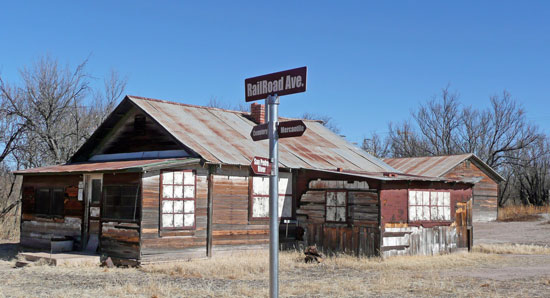
Another day while Judy did her morning run,
Hughes
biked south and west about 20 miles to the ghost town of Fairbank on
the banks of the San Pedro River. Fairbank grew as the site of one of
the mills that worked the silver ore from Tombstone, and was a stop on
the rail line between Bisbee and Benson: ore and cattle went out,
people and goods came in.
When
Judy finished her run, she drove the RV with Sophie and Bella to
Fairbank and we poked around what was once a thriving town. We hiked to
the cemetery and mill a couple of miles north of town. By exploring
ghost towns, we seem to find connections with the past (in some ways, our past) by way of noting who died
and when, as well as how people worked and lived. Fairbank is worth
visiting: there are quite a few buildings still remaining (the town
went ghost in the 1940s, but was lived in until the early 1970s), and
recent funds are slowly helping to restore some of the buildings and
to provide visitor information.
 From Fairbank, we put
the
bike on the RV and drove
on to Tombstone—definitely not a ghost town, though its population has
fluctuated from 5000 in the 1880s to a little over 100 during the
Depression to its current population of about 1,500. Tombstone thrives
on its made-in-Hollywood western mythology: Boot Hill (named after
Dodge City’s more famous cemetery hoping to make it
a tourist attraction); the shady ladies (Is it really true that the
scarlet ladies were confined to walking on the shaded side of the
street?), the OK Corral (the fabled gunfight actually took place in a
vacant lot on Fremont Street), Wyatt Earp and Doc Holiday and all that
western movie kind of stuff). Some of what’s there is definitely hokey and
strictly
to fleece the tourists, but there is a strong sense of western history
that underlies the movie-set facade and is worth knowing about: the
stories of people like Edward
Schieffelin, John Clum,
and Nellie
Cashman, the fabulous riches from the silver mines, and the Tombstone Epitaph, which is still in
print after 110 years of covering the west.
From Fairbank, we put
the
bike on the RV and drove
on to Tombstone—definitely not a ghost town, though its population has
fluctuated from 5000 in the 1880s to a little over 100 during the
Depression to its current population of about 1,500. Tombstone thrives
on its made-in-Hollywood western mythology: Boot Hill (named after
Dodge City’s more famous cemetery hoping to make it
a tourist attraction); the shady ladies (Is it really true that the
scarlet ladies were confined to walking on the shaded side of the
street?), the OK Corral (the fabled gunfight actually took place in a
vacant lot on Fremont Street), Wyatt Earp and Doc Holiday and all that
western movie kind of stuff). Some of what’s there is definitely hokey and
strictly
to fleece the tourists, but there is a strong sense of western history
that underlies the movie-set facade and is worth knowing about: the
stories of people like Edward
Schieffelin, John Clum,
and Nellie
Cashman, the fabulous riches from the silver mines, and the Tombstone Epitaph, which is still in
print after 110 years of covering the west.
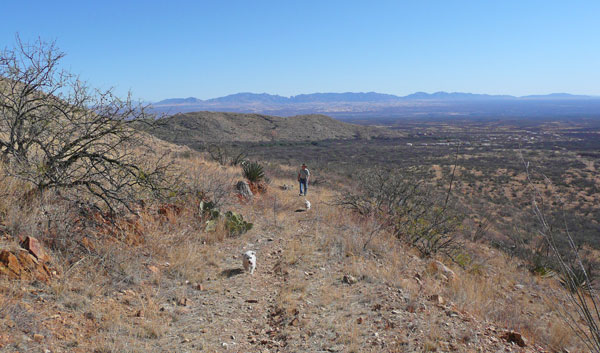
Check out time at Karchner is 2:00, plenty
of time
for a morning run and a 3-4 mile hike into the hills
above the park with the dogs off leash. (Most of the hike was outside
the park in the adjoining National Forest where dogs off leash are
permitted.) Only in the winter months could we enjoy the area as we
did. We returned to give Bella and Sophie baths (in
the RV
shower), to vacuum and clean the RV, and take showers ourselves. We
left for Tucson and our visit with cousin Bob and Ginny.
7. Cave Creek Regional
Park
Our Colorado cousins, Carol and Ken, camped at Cave Creek Park
last year and raved about the facilities and the hiking. They were
right: this Maricopa County Regional Park just north of Phoenix has
wonderfully groomed trails for hiking, horses, and mountain bikers that
course through saguaro forests, outcropping of chalcedony agate, and
thickets of palo
verde, mesquite, ocotillo, creosote, and jojoba where a variety of
birds find homes and protection. The trails are also good for running,
though accessing the trail heads requires a mile of running or biking
up a fairly steep grade from the campground.
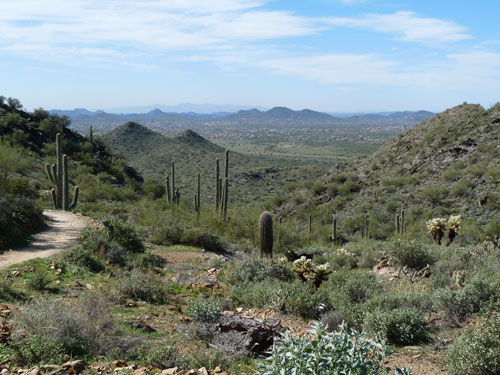 With Phoenix
less than
an hour south, Cave
Creek is
a popular, easy to reach park that takes no reservations. Like our
cousins last year, we spent two nights in the overflow area without
hookups, though the shower/bathrooms were very close by. We were
disappointed to be without electricity for two nights, but it was not a
hardship. We lacked only the privacy of the large sites in the
campground proper. It is always nice to have electricity, but we can
manage easily without it.
With Phoenix
less than
an hour south, Cave
Creek is
a popular, easy to reach park that takes no reservations. Like our
cousins last year, we spent two nights in the overflow area without
hookups, though the shower/bathrooms were very close by. We were
disappointed to be without electricity for two nights, but it was not a
hardship. We lacked only the privacy of the large sites in the
campground proper. It is always nice to have electricity, but we can
manage easily without it.
We spent two of our three days hiking the
Overton
and Go John trails. We took a late afternoon short trail from the
campground to the Clay Mine. The mine was named not for a Mr. Clay, but
for what was taken out of the ground. Lila Pearl Irish bought the
failed gold mine in the 1940s and marketed
“Mineral Springs Clay” to be
mixed with water as an elixir that cured whatever ailed a person. It
actually made a fortune for Lila because her potion turned out to be an
effective
cure for dysentery. The weather was great for being outdoors, one of
our major goals for the trip. There were other trails, but the
landscape is basically the same and we knew we would see little new on
other trails. We have not yet become serious birders, but when we do,
we will return here in the proper season with the right resources
(binoculars, reference books, etc.).
However, what we found most rewarding were the
spectacular sunsets. Each night we took scads of photos (aren't we
grateful for digital photography?) with saguaros and ocotillos
silhouetted against red clouds and blue-tinted skies. One sunset was
more
more glorious than the one before; each was a postcard photo that the
Arizona Chamber of Commerce would die for!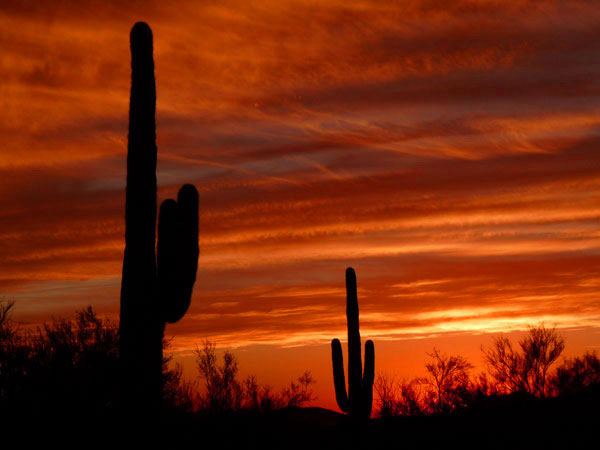
We took one afternoon to return to The
Town Dump, one of our favorite shopping experiences in the nearby
town of Cave Creek.
Part junk, part folk art, part Mexican crafts, and part reclamation
from
old buildings, this is the “best” of several similar antique and junque
stores in the quirky little town of Cave Creek (a sort of Nederland in
the high desert). It’s worth the drive and at least an
hour of
your time to find that special, unexpected treasure.
8. Sedona
Our last stop before heading home was Sedona, one of
our favorite towns in Arizona. We stay at Los
Abrigados Resort and Spa
when we go, and in the past we have enjoyed great hiking, biking,
dining, shopping,
and relaxing in this scenic red rocks area. We always find new areas
and opportunities to explore, whether it
’s a new trail in the red rocks
area or in
Oak Creek Canyon, or poking through galleries in Sedona or in nearby
Jerome and having a great
hamburger and an outstanding margarita The
Haunted Hamburger overlooking town.
This time, however, we were there for Judy to run in
the 5K race that is run along with the Sedona marathon and half
marathon. We camped the night before the race at the Rancho Sedona RV Park, a very
pleasant stopover for us. We walked the dogs along Oak Creek that
fronts the campground, we photographed at least a dozen blue herons
nesting high in the trees that shade the park in the summer, and we
drained our water system and winterized in preparation for the winter
weather still to come at home.
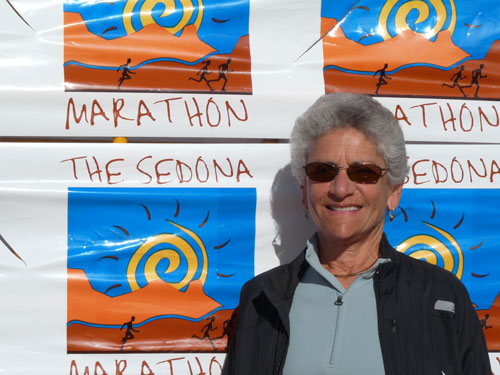 We were up at 5:30
and down
to the Sedona Cultural
Center for the start of the races. The chilly morning warmed as the sun
came up, which created a lovely red rock setting for the race. Judy did
well (she must have felt the pull of a Sedona
vortex): She won
her age group by six minutes and beat every woman over 50 except
for a very fast 54-year-old from Kalispell, Montana. Judy said it was
the toughest 5K she has ever run: nothing was flat. It was either
uphill or down. The morning race was a great way to finish our Arizona
trip.
We were up at 5:30
and down
to the Sedona Cultural
Center for the start of the races. The chilly morning warmed as the sun
came up, which created a lovely red rock setting for the race. Judy did
well (she must have felt the pull of a Sedona
vortex): She won
her age group by six minutes and beat every woman over 50 except
for a very fast 54-year-old from Kalispell, Montana. Judy said it was
the toughest 5K she has ever run: nothing was flat. It was either
uphill or down. The morning race was a great way to finish our Arizona
trip.
Going
Home
We filled with diesel in Flagstaff and
headed east across Arizona. It’s a dull trip—we really should find some
good books on tape/CD—so we had time to notice the following:
1. Most of the vehicles on the interstate, even on a
weekend, are trucks!
2. At least a dozen trains were traveling west, each
loaded with a long string of flat bed cars carrying either semi
trailers or shipping
containers. If the economy is in a downturn, what accounts for the
movement of so many goods? Along with trucks, there is a lot of
commerce being shipped from here to there.
3. Billboards
are not longer painted on wood or printed on paper and then glued to
boards. They are virtually all printed (painted?) on vinyl or cloth
(nylon? canvas?) and attached somehow. Bad news for traditional
billboard paper hangers and good news for folks who make printers,
print images on cloth, et al.
4. Winslow to Gallup is empty. Is that why the meteor
made the crater where it did? Because nothing was there? It made us
think of US 50 across Nevada.
5. We experienced our first real major traffic snarl:
a truck caught fire in a work zone between Gallup and Grants. We moved
a mile in about an hour and a half before we were able to get diverted
to a frontage road.
We spent the night at the Bar
S RV Park in Grants: $13.50/night included free wi-fi, cable TV,
and full hook-ups. That’s so inexpensive we were
embarrassed to
take the 10% Good Sam discount. The owner asked that we not keep the
water line hooked up over night because of the possibility of stormy
weather. This was, of course, no problem since we had drained the water
lines and hot water heater in Sedona and filled the lines with
antifreeze. It did freeze overnight, but we used our space heater for
the night and we slept comfortably!
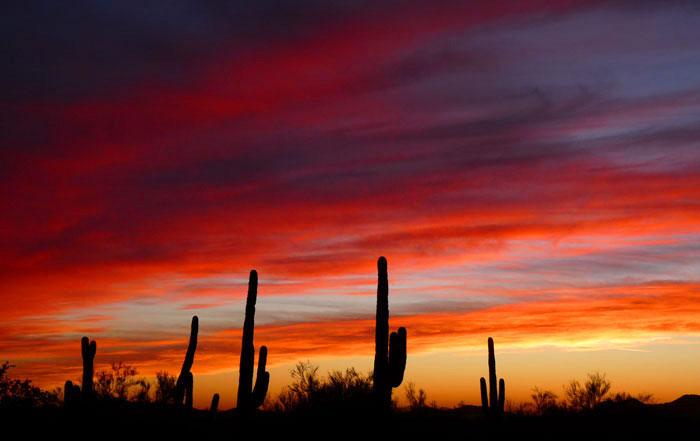
Hearing
that a
storm was building up, we decided to make the big push to get
home from Grants in one day. This is not a hard drive, just a longer
day than we had been used to for the past few weeks. It was a smart
thing to do: the night we arrived home, Flagstaff got hit with over 2'
of new snow. We had light snow between Las Vegas (NM) and Raton,
but—and this sounds hard to believe, but it’s the way it happened—the moment
we
crossed over Raton Pass and the Colorado line, the skies dramatically
turned blue and clear. It was like that all the way home.
Now
That We're Home…
Arizona had the warm temperatures we hoped.
There
were lots of
interesting places to go and things to do. We saw friends and family.
Sophie and Bella were with us to keep us smiling. We explored new
places and learned about some others we want to visit. We renewed at
least two interests—rockhounding and birding. We were so busy that Judy
didn’t
finish one book in the entire trip.
We are already looking forward to next winter.
And many more Arizona sunsets.







 In the
afternoon, Jim took us to Saguaro
National Park
(the west section);
Sandi preferred to take care of the dogs, whom she seems to adore. We
stopped by Jeb’s Rock Shop on the way to look over his collection of
local and imported specimens and be audience to his stories
about rock collecting and gemstones. We stopped at the National Park
Visitors Center to
find out where we might take a gentle hike. The Bajada Loop Road took
us to Signal Hill picnic area (built by the CCC in 1934), which is a
short walk to
the
location of petroglyphs on a rock outcropping. We found several saguaro
boots (see photo on left) and one rare cristate
(or crowned) saguaro, which occurs in about one in 200,000 saguaros.
In the
afternoon, Jim took us to Saguaro
National Park
(the west section);
Sandi preferred to take care of the dogs, whom she seems to adore. We
stopped by Jeb’s Rock Shop on the way to look over his collection of
local and imported specimens and be audience to his stories
about rock collecting and gemstones. We stopped at the National Park
Visitors Center to
find out where we might take a gentle hike. The Bajada Loop Road took
us to Signal Hill picnic area (built by the CCC in 1934), which is a
short walk to
the
location of petroglyphs on a rock outcropping. We found several saguaro
boots (see photo on left) and one rare cristate
(or crowned) saguaro, which occurs in about one in 200,000 saguaros. 
 We stayed three
nights at the
Desert Cypress RV Park, a
comfortable and quiet place close to town and to dirt roads for
biking and running. Paul and Barb Root were the very pleasant and
helpful managers on site while we were there; in fact, Paul spent a
good hour fixing the cable TV connection that had
been
undone by the folks who installed the TV converter box back in the fall
and didn't properly test the system before I picked it up. (Having a
working TV permitted us to watch the Arizona Cardinals win a spot in
the Super Bowl and the inauguration of Barack Obama. We may have been
the only ones in the park or town watching the inauguration, though
everyone watched the Cardinals beat the Eagles.) We had planned for
only one night, but stayed two more.
We stayed three
nights at the
Desert Cypress RV Park, a
comfortable and quiet place close to town and to dirt roads for
biking and running. Paul and Barb Root were the very pleasant and
helpful managers on site while we were there; in fact, Paul spent a
good hour fixing the cable TV connection that had
been
undone by the folks who installed the TV converter box back in the fall
and didn't properly test the system before I picked it up. (Having a
working TV permitted us to watch the Arizona Cardinals win a spot in
the Super Bowl and the inauguration of Barack Obama. We may have been
the only ones in the park or town watching the inauguration, though
everyone watched the Cardinals beat the Eagles.) We had planned for
only one night, but stayed two more. 
 After leaving Vulture City, we continued west on US 60 to
Wenden and turned north toward Alamo Lake to dry camp on BLM land
somewhere on Bonanza
Mine Road near the slopes of the Harcuvar Mountains. Before sunset, we
pulled off on a level spot where we could
hear nothing, where the stars were not dimmed by city lights, and
where the sunset and the sunrise (pictured here) were spectacular. We
had a warm dinner, a long walk with the dogs, and
slept warm and peacefully. Some would say we finally did some camping
(even though we slept in our RV).
After leaving Vulture City, we continued west on US 60 to
Wenden and turned north toward Alamo Lake to dry camp on BLM land
somewhere on Bonanza
Mine Road near the slopes of the Harcuvar Mountains. Before sunset, we
pulled off on a level spot where we could
hear nothing, where the stars were not dimmed by city lights, and
where the sunset and the sunrise (pictured here) were spectacular. We
had a warm dinner, a long walk with the dogs, and
slept warm and peacefully. Some would say we finally did some camping
(even though we slept in our RV). 
 We tried to
imagine
500 people or
more living out here toiling
in the mines for copper. Fifty tons a day were taken either to the
Colorado River and on to Wales, or to the railroad headed for
Wickenburg
or Parker.) Discovered in 1882, developed in 1886, the mines were
profitable from 1908 until they petered out in the Depression and the
town went ghost in the 1940s. This isolated, desolate area supported a
school, newspaper, electric company, post office, movie house,
hospital, and housing for hundreds of men, women, and children.
The beauty of the town in the winter months, when the temperature is in
the low 70s, hides the harsh reality of summer heat well over 115°.
Swansea (originally named Signal) is a world away from the Welsh town
that was its namesake. All that remains of the community that once gave
hope of prosperity are the adobe rubble of living quarters, the smelter
and dust chamber, the foundations of stores and company offices, and
the glory hole that yielded the ore.
We tried to
imagine
500 people or
more living out here toiling
in the mines for copper. Fifty tons a day were taken either to the
Colorado River and on to Wales, or to the railroad headed for
Wickenburg
or Parker.) Discovered in 1882, developed in 1886, the mines were
profitable from 1908 until they petered out in the Depression and the
town went ghost in the 1940s. This isolated, desolate area supported a
school, newspaper, electric company, post office, movie house,
hospital, and housing for hundreds of men, women, and children.
The beauty of the town in the winter months, when the temperature is in
the low 70s, hides the harsh reality of summer heat well over 115°.
Swansea (originally named Signal) is a world away from the Welsh town
that was its namesake. All that remains of the community that once gave
hope of prosperity are the adobe rubble of living quarters, the smelter
and dust chamber, the foundations of stores and company offices, and
the glory hole that yielded the ore.




 From Fairbank, we put
the
bike on the RV and drove
on to Tombstone—definitely not a ghost town, though its population has
fluctuated from 5000 in the 1880s to a little over 100 during the
Depression to its current population of about 1,500. Tombstone thrives
on its made-in-Hollywood western mythology: Boot Hill (named after
Dodge City’s more famous cemetery hoping to make it
a tourist attraction); the shady ladies (Is it really true that the
scarlet ladies were confined to walking on the shaded side of the
street?), the OK Corral (the fabled gunfight actually took place in a
vacant lot on Fremont Street), Wyatt Earp and Doc Holiday and all that
western movie kind of stuff). Some of what’s there is definitely hokey and
strictly
to fleece the tourists, but there is a strong sense of western history
that underlies the movie-set facade and is worth knowing about: the
stories of people like Edward
Schieffelin, John Clum,
and Nellie
Cashman, the fabulous riches from the silver mines, and the Tombstone Epitaph, which is still in
print after 110 years of covering the west.
From Fairbank, we put
the
bike on the RV and drove
on to Tombstone—definitely not a ghost town, though its population has
fluctuated from 5000 in the 1880s to a little over 100 during the
Depression to its current population of about 1,500. Tombstone thrives
on its made-in-Hollywood western mythology: Boot Hill (named after
Dodge City’s more famous cemetery hoping to make it
a tourist attraction); the shady ladies (Is it really true that the
scarlet ladies were confined to walking on the shaded side of the
street?), the OK Corral (the fabled gunfight actually took place in a
vacant lot on Fremont Street), Wyatt Earp and Doc Holiday and all that
western movie kind of stuff). Some of what’s there is definitely hokey and
strictly
to fleece the tourists, but there is a strong sense of western history
that underlies the movie-set facade and is worth knowing about: the
stories of people like Edward
Schieffelin, John Clum,
and Nellie
Cashman, the fabulous riches from the silver mines, and the Tombstone Epitaph, which is still in
print after 110 years of covering the west. 
 With Phoenix
less than
an hour south, Cave
Creek is
a popular, easy to reach park that takes no reservations. Like our
cousins last year, we spent two nights in the overflow area without
hookups, though the shower/bathrooms were very close by. We were
disappointed to be without electricity for two nights, but it was not a
hardship. We lacked only the privacy of the large sites in the
campground proper. It is always nice to have electricity, but we can
manage easily without it.
With Phoenix
less than
an hour south, Cave
Creek is
a popular, easy to reach park that takes no reservations. Like our
cousins last year, we spent two nights in the overflow area without
hookups, though the shower/bathrooms were very close by. We were
disappointed to be without electricity for two nights, but it was not a
hardship. We lacked only the privacy of the large sites in the
campground proper. It is always nice to have electricity, but we can
manage easily without it.
 We were up at 5:30
and down
to the Sedona Cultural
Center for the start of the races. The chilly morning warmed as the sun
came up, which created a lovely red rock setting for the race. Judy did
well (she must have felt the pull of a Sedona
vortex): She won
her age group by six minutes and beat every woman over 50 except
for a very fast 54-year-old from Kalispell, Montana. Judy said it was
the toughest 5K she has ever run: nothing was flat. It was either
uphill or down. The morning race was a great way to finish our Arizona
trip.
We were up at 5:30
and down
to the Sedona Cultural
Center for the start of the races. The chilly morning warmed as the sun
came up, which created a lovely red rock setting for the race. Judy did
well (she must have felt the pull of a Sedona
vortex): She won
her age group by six minutes and beat every woman over 50 except
for a very fast 54-year-old from Kalispell, Montana. Judy said it was
the toughest 5K she has ever run: nothing was flat. It was either
uphill or down. The morning race was a great way to finish our Arizona
trip. 
